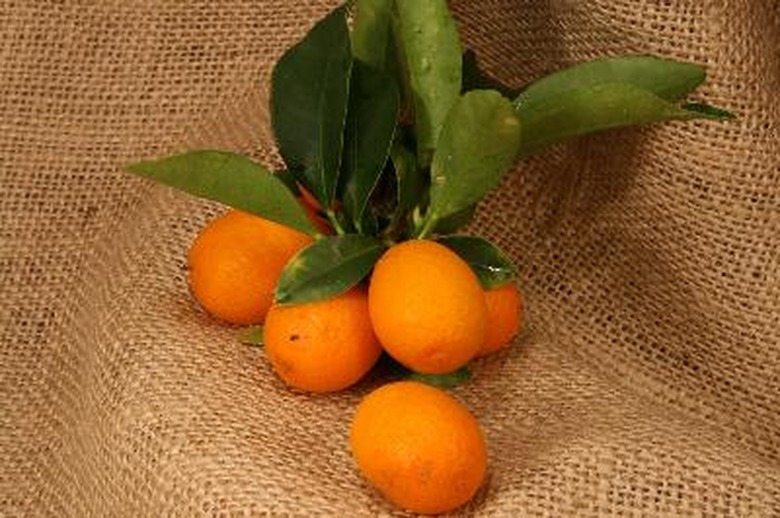What Can Be Wrong When My Kumquat Tree Keeps Losing Leaves?
The kumquat is a slow-growing, shrubby plant often grouped with citrus. The tree, which is likely native to China, can be grown outdoors in warm climates but is compact and short enough to grow as a potted plant indoors in northern climates. Kumquat feature dark-green glossy leaves and sweetly fragrant white flowers that mature into oblong or round golden to reddish-orange inch-wide fruits with three to six pulp-containing acidic segments. Kumquats keep food reserves in their leaves, so any leaf drop should be considered a call for attention.
Improper Soil Moisture
Improper Soil Moisture
Too much or too little available soil moisture can cause kumquat trees to drop leaves. Water is often applied too frequently in insufficient amounts. Use a can test to determine how frequently the tree should be watered. Fill a can with 2 inches of water. Whenever the water in the can is completely evaporated, water the tree with an inch to an inch and a half of water and refill the can. Apply the water at a rate that does not permit runoff. Kumquats cultivated in containers require more frequent watering.
Cold Damage
Cold Damage
Kumquat trees lose leaves and fruit after severe freezes, although the kumquat is known to be hardy below 20 degrees Fahrenheit. Delay pruning until after any dieback occurs, even if the tree is unsightly in the landscape for a few months. Try to prevent cold damage. If the kumquat is container grown, bring it indoors or to a sheltered area. If it is planted in the landscape, remove mulch from around the tree, thoroughly water the soil, cover the tree and consider using a heater.
Pest Damage
Pest Damage
Kumquats are susceptible to several diseases or pests. Some of these may cause leaf drop but trees frequently show earlier, more indicative symptoms that will help to identify and treat for the specific pest. Pot-grown kumquats may be infested by mealybugs. Kumquats can be affected by scab, algal leaf spot, greasy spot, anthracnose, melanose, fruit rot, stem-end rot and gummosis. Mite damage is also a common cause of leaf drop.
Natural Drop
Natural Drop
Healthy trees naturally shed even healthy-looking leaves. Leaves only live for 18 to 24 months and then drop. This drop is typically most noticeable and falsely alarming in the spring but occurs throughout the year.
Rapid Changes in Light
Rapid Changes in Light
If the kumquat is container grown and moved for protection from cold temperatures, rapid changes in light can force leaf drop. Acclimate trees that are moving indoors for the winter or outdoors in spring. Slowly reduce or increase the amount of daily light over two to four weeks.
Root Problems
Root Problems
If the kumquat is container grown and becomes rootbound, twigs will die back and leaves will drop because the capability of the root system is not balanced with the needs of the canopy. Moderately prune the top back to better match the root system or repot the kumquat to a larger container.
References
- Texas A&M System AgriLIFE Extension; Home Fruit Production — Citrus; Julian W. Sauls
- Pasco County Cooperative Extension Service; Get Acquainted With Kumquat; BJ Jarvis
- Fruits of Warm Climates; Julia F. Morton; 1987
- Alabama Cooperative Extension Service; Citrus for Southern and Coastal Alabama; Arlie Powell, et al.; September 1998
